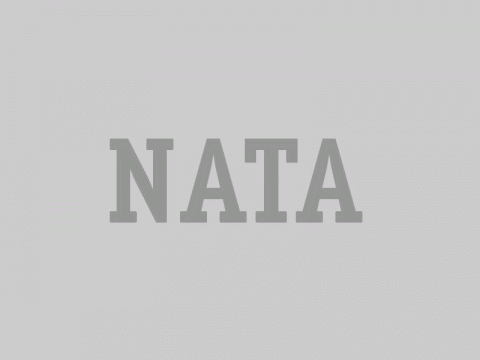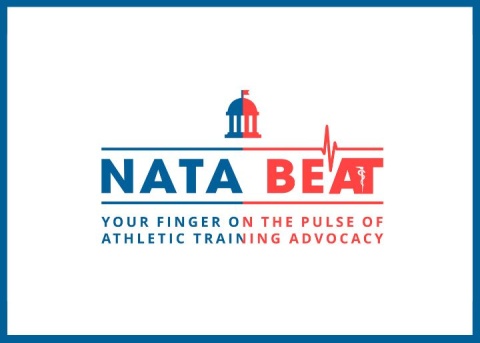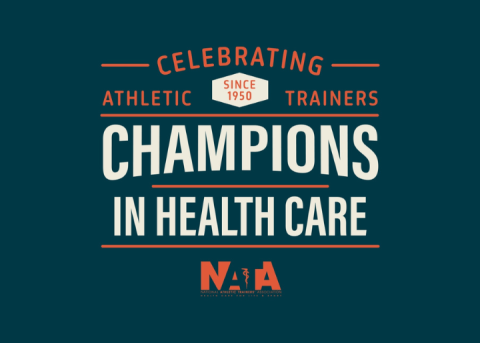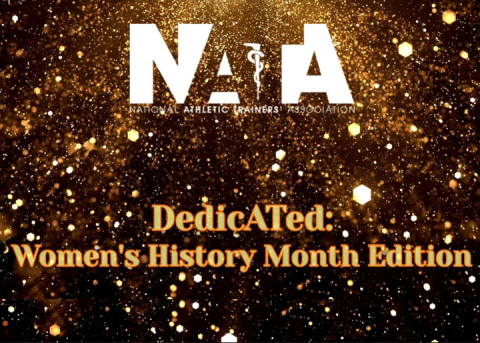
In her office at Radio City Music Hall, old magazines and photos of the Radio City Rockettes through the years decorate the walls. As she sits at her desk, Elaine Winslow-Redmond, MS, ATC, EMT, head athletic trainer and director of athletic training and wellness for the Radio City Rockettes, recalls how the cozy room once served as the entire athletic training treatment area many years ago.
“I remember wanting to be treated as an athlete myself,” she recalled of the dancing segment Rockettes career, which lasted 11 years. “While I was injured we didn’t have a lot of support for Rockettes with injuries.”
Wanting to change the status quo, Elaine set her sights on a master’s degree in athletic training so she’d be able to offer more treatment to her fellow dancers. “There was a huge need,” Elaine noticed. “[the Rockettes] are a perfect match because we all have to be on the stage: You can only have so many understudies for any given position, so it’s very challenging if you don’t have everybody healthy.”
Athletic Training: A Perfect Match
Like the Cirque du Soleil sports medicine model, the Rockettes’ treatment program is rooted in the foundation of athletic training. protocols although they treat different injuries. “We err on the side of prevention, and I think that’s important — it’s better to prevent than to have multiple injuries and treat them after the fact,” she said.
The second major athletic training principle she wanted to bring to the program was treating the dancers as athletes, a concept to which some of the dancers are relatively new. “Things like putting feet in ice tubs are common to a collegiate athlete, but some of our dancers didn’t have that in their dance program,” Elaine said. “Or a dance studio might not have the same support you might have in a high school with an AT.”
Elaine said the team of Rockettes had to be taught to think like athletes, especially when it comes to sustaining injuries, which in turn helps them understand the importance of rest and rehab in order to heal and improve. For many competitive personalities and extreme individuals, performing through pain for fear of being cut from the team or replaced by an understudy seems like a necessary alternative. “I think the mindset is often, ‘We’re going to work through this, we’re going to dance through this,’ but they need to know what’s safe and what’s not safe, and I can explain it and make recommendations based on my own experience.”
A Proposal for Prevention
In between Rockette rehearsals and Radio City Christmas Spectacular performances in Las Vegas, Elaine started taking graduate classes at the University of Nevada Las Vegas. During the summer she was also working with football players during two-a-day sessions, and planned to earn degrees in exercise physiology and nutrition to supplement the foundation of athletic training.
She soon transferred to Columbia University in New York City, where she remained dancing with the Rockettes and took on another athletic training assistantship, this time with Columbia football athletic trainer Jim Gossett, MS, ATC. “[I was] learning the craft and understanding prevention [and] getting to know the mindset of ATs and how they treat their athletes,” she remembered.
After completing her master’s thesis, which assessed the need, cost and benefit of an athletic training program for the Rockettes, she pitched the proposal to Madison Square Garden in 1997, which had acquired both Radio City Music Hall and the Rockettes.
To gather and analyze the data for the thesis proposal, Elaine used stage manager reports from Rockettes shows in which she’d performed over a five-year period and analyzed the numbers related to an injury. While not written in detail, the stage manager notes will document when injuries occur, stage cues are missed, or a similarly relevant event occurs backstage.
“I basically did a needs assessment [to show] there was a need to prevent injuries, most of which were musculoskeletal, repetitive stress/overuse injuries,” she explained. “So it made perfect sense that we could show how athletic trainers could prevent those types of injuries and inevitably our numbers would decrease.”
And although the Rockettes’ first facility may have begun as a tiny space in the corner of a dressing room, recognition and trust for the program expanded as the dancers not only healed their athletes but grew into stronger athletes. Little by little, the AT facility added a hydro therapy room here, some closet space and extra supplies there.
Rockette Research By the Numbers
“As years went on program grew and we started to show the company we had huge numbers in prevention – making a real difference in workers compensation claims, decreasing the number of injuries, and keeping women in the show,” Elaine said. “At the same time, our show was increasing in athleticism; we were adding new numbers, new shows and new Rockettes to lineup.” Four years ago, MSG funded a newly renovated AT facility for the Rockettes, evidence of MSG’s continued support for and faith in the program.
Elaine said the program’s success is in part due to her inside experience as a dancer; first, she understands to the women’s’ dedication to succeed, their perseverance, and the urge to continue practicing despite needing rest or getting hurt. “They’re doing 17 shows a week in front of a live audience,” Elaine said, with sometimes four 90-minute shows a day during the holiday season. “There’s a lot of fatigue — the kind you can’t explain unless you’ve maybe done a triathlon; your muscles are exhausted but you have to rejuvenate,” she said. (Granted, each show’s choreography includes more than 200 signature Rockette high kicks each, meaning the dancers will have done well over 800 by the end of one evening at Rockefeller Center.)
Despite the numbers of dancers, high kicks and square footage for the AT facility gradually going up, the injury statistics, as Elaine predicted, have decreased. “When we started numbers were in hundreds, upwards of 300,” Elaine said. Now we’re talking less than100 — maybe 60 or 70 injuries in a season – which is pretty amazing considering there are 157 performers in the entire show (which includes 80 Rockettes plus additional performers) and 205 shows a season.”
Performing Arts Opportunities
Having worked with football teams at UNLV and Columbia, Elaine said the Rockettes are no different from any other athlete performing at the elite level. “They really have such dedication and I admire these women for making it through such a grueling schedule.” Nevertheless, the types and rates of injury are unique, with the majority of reports citing repetitive stress/overuse injuries in the feet, ankles and lower leg. Acute injuries, ACL tears and concussions occur rarely, but there is a strict protocol for head injuries in place if one does occur.
“While working football camp I saw several concussions in one week; here, we hope we don’t ever see those,” she said, but if it does the implications can be much different. For example, a much lower risk of second impact syndrome exists in the dance realm than on the football field. “It certainly complicates things when you add stage lights, costumes and moving parts of the stage,” she said, not to mention the injury’s potential to keep dancers from performing in a show.
With visible professional growth growing within the performing arts and military settings, Elaine predicted more will positions will eventually open up. She also said it’s up to health care providers to educate performing arts producers, directors, stage managers, choreographers and other individuals on the importance of injury prevention, but challenged ATs and AT students to, like her, use their own initiative, resourcefulness and professional skills to cultivate their own business opportunities. Research the concept, take time to properly gather and evaluate the data in order to demonstrate the value of the proposal.
“It’s really important for other athletic trainers to take their idea and run with it, but they have to know the business side: They have to 1) know there’s a need, 2) show there’s a need, and 3) go further to show how that need is going to help the organization they’re pitching the idea to or working for,” Elaine said. (Read about Elaine’s former intern Monica Lorenzo, ATC, and how she adjusted the Rockettes AT program to fit the needs of the Knicks City Dancers in NATA News.)
“Create something for yourself — go out there, find a niche, find what it is and work towards it,” she said. “Once you get that niche, understand how to explain it and explain it well, it’s a win-win for everybody.”
-Posted by NATA News Managing Editor Jaimie Siegle (jaimies@nata.org)
Photo by Jaimie Siegle / NATA
From left: Assistant AT and Knicks City Dancers AT Monica Lorenzo, MS, ATC, CES; Assistant AT Meg Schneider, MS, ATC; Head AT Elaine Winslow, MS, ATC, EMT; Assistant AT Gail Ayotte, MSEd, ATC, EMTb; and Assistant AT Kendra Sakamoto, MS, ATC, CSCS. Not pictured: Assistant ATs Karen Kubicina, ATC; Jaimie Doherty, MSEd, ATC, NREMT; Kori KIrschner, MS, ATC




